The p65 subunit of nf-kb for the radiosensitization of cells
a radiosensitization and p65 subunit technology, applied in the direction of antibody medical ingredients, peptide/protein ingredients, peptide sources, etc., can solve the problems of non-specific effects of tested chemicals, difficult to ascertain the effect of cellular radiosensitization, etc., to reduce nf-b signal-induced activation, decrease nf-b activation, and increase free nf-b
- Summary
- Abstract
- Description
- Claims
- Application Information
AI Technical Summary
Benefits of technology
Problems solved by technology
Method used
Image
Examples
examples
[0036] Materials and Methods
[0037] Cell culture, Transfection and Clonal Selections: Human head and neck squamous carcinoma cells (SCC-35) were used for the experiments described. These cells have been previously characterized as resistant to ionizing radiation based on clinical and radiobiological parameters (30). Cells were cultured in 10 cm2 dishes and maintained in Dulbeco modified Eagle's medium supplemented with 10% fetal bovine serum, 2 mML-amino acids. Cells were passaged routinely at 80-90% confluence and checked for mycoplasma contamination at three-month intervals. For transfection and clonal selections, logarithmically growing cells were transfected with 5 μg of plasmid DNA, using Lipofectamine (5 μg / ml) (BRL) as suggested by the manufacturer (GIBCO). For the stable clonal selection, cells were transfected with the plasmid DNA containing the NH2-terminus p65 by using Lipofectamine (Gibco) as suggested by the manufacturer. G418 resistant clonal cells were then subcloned ...
PUM
| Property | Measurement | Unit |
|---|---|---|
| pH | aaaaa | aaaaa |
| pH | aaaaa | aaaaa |
| emission wavelengths | aaaaa | aaaaa |
Abstract
Description
Claims
Application Information
 Login to View More
Login to View More - R&D
- Intellectual Property
- Life Sciences
- Materials
- Tech Scout
- Unparalleled Data Quality
- Higher Quality Content
- 60% Fewer Hallucinations
Browse by: Latest US Patents, China's latest patents, Technical Efficacy Thesaurus, Application Domain, Technology Topic, Popular Technical Reports.
© 2025 PatSnap. All rights reserved.Legal|Privacy policy|Modern Slavery Act Transparency Statement|Sitemap|About US| Contact US: help@patsnap.com



